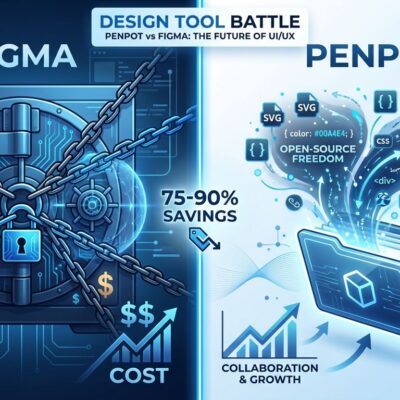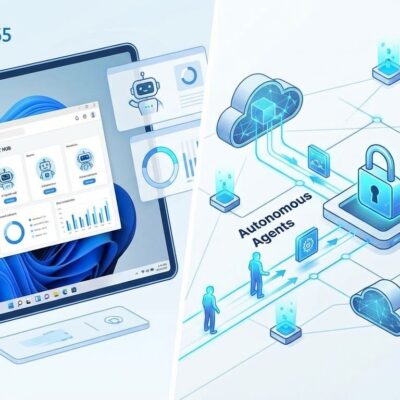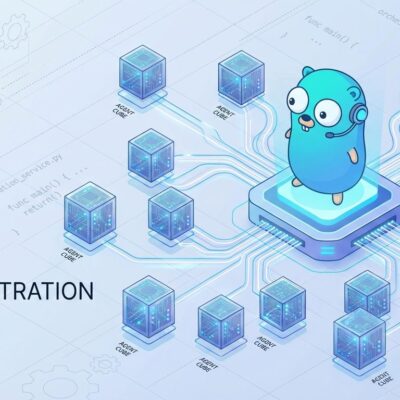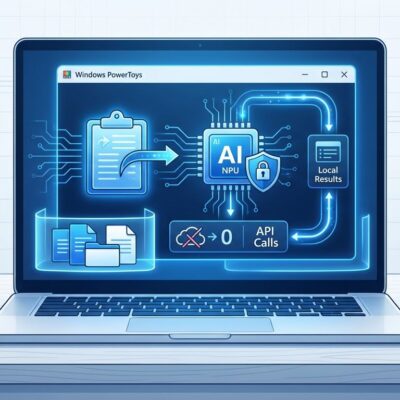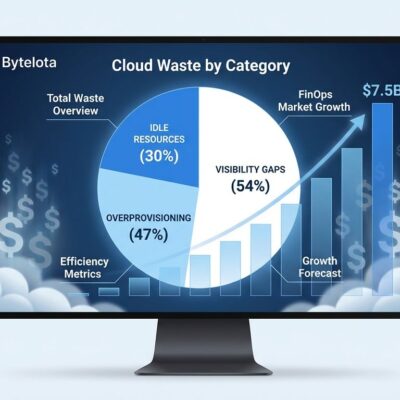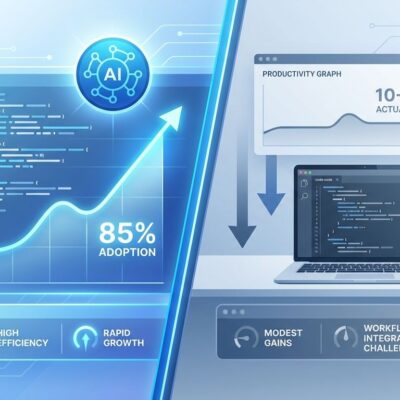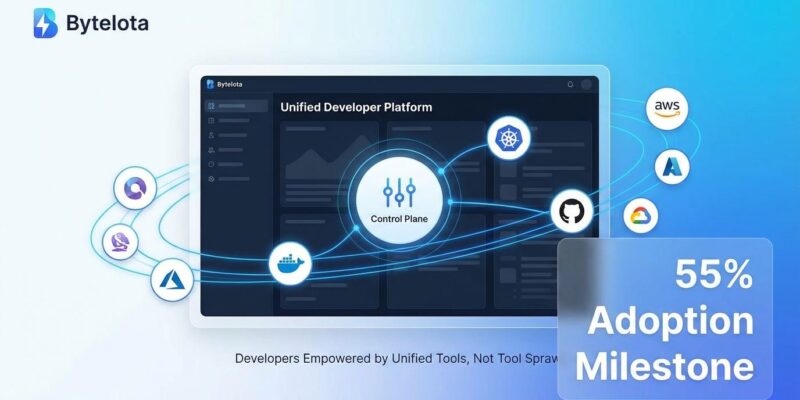
Platform engineering just crossed the 55% adoption threshold, marking the shift from early adopter territory to mainstream practice. If your organization hasn’t started building an internal developer platform, you’re now in the minority. This isn’t DevOps rebranded or another passing trend. It’s a fundamental rethinking of how developers interact with infrastructure, backed by measurable productivity gains and a rapidly maturing ecosystem.
What Drove the Tipping Point
Four converging forces pushed platform engineering from niche practice to mainstream necessity in 2025.
Tool sprawl hit unsustainable levels. The average engineering team now juggles 10+ DevOps tools, transforming developers into tool administrators instead of builders. Context switching between fragmented tooling creates cognitive overload that directly impacts productivity. What started as best-of-breed tool selection became an operational nightmare.
Multi-cloud complexity accelerated the problem. With 84% of enterprises running multi-cloud strategies, developers face a maze of provider-specific interfaces, APIs, and configurations. Platform engineering provides the abstraction layer that makes multi-cloud viable – developers provision resources through a unified interface instead of mastering AWS, Azure, and GCP simultaneously.
Developer experience became a competitive advantage. The platform-as-a-product mindset treats developers as customers, not users. Internal developer platform adoption jumped from 23% in Q3 2024 to 27% in 2025, with 49% of teams citing “reducing repetitive tasks” as their primary driver. Self-service infrastructure eliminates ops bottlenecks – developers request resources via portal or API instead of filing tickets.
The ecosystem matured beyond proof-of-concept. Backstage dominates with 3,400+ adopters and 89% market share, becoming the 4th most contributed to CNCF project behind only Kubernetes, OpenTelemetry, and Argo. Meanwhile, commercial alternatives like Cortex ($60M Series C) and Port ($60M funding) prove turnkey solutions can compete with open source customization. The CNCF even launched a platform engineering certification program, with 13,000 developers already certified.
The Productivity Data Backs It Up
Platform engineering delivers concrete, measurable ROI. Time-to-market improved by 37% for cloud adopters, while application development productivity increased by 38%. Forrester research confirms companies adopting platform engineering practices can reduce time-to-market by up to 25%.
Spotify’s internal results showcase what’s possible. The company achieved 99% voluntary portal adoption internally, with 96% of all R&D workers – not just developers – using Backstage for their software development lifecycle. That’s not mandated compliance. That’s developers choosing the platform because it makes their work easier.
The metrics that matter in 2025 go beyond vanity numbers. Early-stage platforms prioritize onboarding time, developer satisfaction, and service creation time – metrics that directly reflect usability and adoption barriers. As platforms mature, teams layer in DORA metrics like deployment frequency and lead time to measure systemic improvements. The SPACE framework (Satisfaction, Performance, Efficiency) provides the holistic view that captures both developer sentiment and operational outcomes.
Backstage Dominates, But Competition Is Healthy
Backstage holds 89% market share among internal developer portals and 67% overall market penetration. With 3,400+ adopters including Airbnb, Booking.com, H&M, LEGO, and Netflix, it’s the undisputed open-source leader. The ecosystem includes 1,600 contributors and 230+ plugins integrating with Argo CD, Datadog, GitHub Actions, Grafana, Snyk, and Terraform.
But Spotify’s success doesn’t guarantee yours. While Spotify reports 99% adoption internally, other organizations implementing Backstage average around 10% adoption. That’s not a tool problem. That’s an execution problem.
Gartner’s 2025 Market Guide for Internal Developer Portals notes organizations increasingly favor turnkey commercial IDPs that “simplify initial deployment, ease ongoing maintenance, and provide out-of-the-box functionality.” This market shift from DIY to commercial reflects a pragmatic reality: not every organization has Spotify’s resources or commitment to maintain a complex open-source platform.
Cortex and Port raised $60M each in 2025, validating the commercial IDP market. The trade-offs are clear. Backstage offers maximum customization, the largest ecosystem, and zero licensing costs – but requires 12-18 months of setup and dedicated internal expertise. Commercial tools deliver faster time-to-value (weeks instead of months), ongoing support, and turnkey functionality – but introduce vendor lock-in and subscription costs.
AI integration is pushing the ecosystem forward. 92% of CIOs plan AI implementation in platforms for 2025, adding intelligent code completion, automated testing, configuration generation, and conversational interfaces for infrastructure requests. Google’s Gemini Cloud Assist and AWS Q Developer already integrate platform engineering workflows, signaling where the market is headed.
But 70% of Platform Teams Still Fail
Despite the hype and adoption numbers, up to 70% of platform engineering teams fail to deliver impact. The gap between Spotify’s 99% adoption and the industry average of 10% reveals the uncomfortable truth: tool choice matters less than execution.
Portal obsession kills projects. Teams spend 12-18 months installing Backstage, launch it with fanfare, then watch adoption stall at zero. They mistake the portal for the platform, focusing on UI polish while ignoring the underlying developer needs. A beautiful frontend for a painful backend just makes the pain more visible.
Lack of product mindset dooms platforms before they launch. Platform teams treating their work as an infrastructure project instead of a product build tools that don’t resonate with developer needs. No product manager, no roadmap, no user research – just engineers building what they think developers want. The result is predictable: low adoption, wasted investment, and frustrated stakeholders.
Overengineering accelerates failure. Adding every feature and capability increases complexity and maintenance overhead. Developers get frustrated navigating elaborate configurations for simple use cases. The platform becomes part of the problem it was supposed to solve.
Success requires treating developers as customers. Start small with a developer portal and golden paths for 2-3 common scenarios. Measure adoption and satisfaction from day one. Invest in a product manager for the platform team. Iterate continuously based on user feedback. The 30% of teams that succeed follow this playbook. The 70% who fail skip these fundamentals.
What This Means for Your Team
At 55% adoption, platform engineering crossed from experimental to essential. The question isn’t whether to adopt – it’s how quickly you can execute while avoiding the pitfalls that claim 70% of teams.
For engineering leaders, the calculus is straightforward. Don’t ask “Should we invest in platform engineering?” Ask “How fast can we move without joining the 70% who fail?” Start small: a developer portal plus 2-3 golden paths for your most common scenarios (web app deployment, data pipeline, API). Hire a product manager for the platform team, not just infrastructure engineers. Measure from day one: time-to-onboard, adoption rate, developer satisfaction. Iterate based on feedback, not assumptions.
Tool selection depends on team size and resources. Large teams with 500+ developers should seriously evaluate Backstage – the customization is worth the investment at scale. Mid-size teams (50-500 developers) face a legitimate build-vs-buy decision: assess Cortex or Port against Backstage based on internal expertise and velocity requirements. Small teams under 50 developers should lean toward commercial tools for faster time-to-value unless platform engineering is a core competency.
For individual developers, the shift is already underway. Self-service infrastructure is becoming table stakes, not competitive advantage. Learning platform engineering concepts pays dividends – the CNCF certification program provides a structured path. Provide feedback to your platform team or start advocating for one if your organization lacks platform engineering capability. Embrace golden paths instead of custom configurations for every service. The cognitive load reduction is real.
Platform engineering hit mainstream adoption in 2025. The ecosystem matured, the ROI is proven, and the commercial market validates the business case. But success requires execution discipline that 70% of teams lack. The wait-and-see period is over. The productivity gap between organizations with platforms and those without widens daily.

